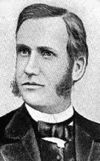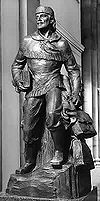- Marcus Whitman
-
Marcus Whitman 
Marcus Whitman by Paul KaneBorn September 4, 1802
Federal Hollow, New YorkDied November 29, 1847 (aged 45)
Waiilatpu, Oregon CountryEducation Fairfield Medical College Spouse Narcissa Prentiss Church Protestant Congregations served Whitman Mission Title Missionary Marcus Whitman (September 4, 1802 – November 29, 1847) was an American physician and Oregon missionary in the Oregon Country. Along with his wife Narcissa Whitman he started a mission in what is now southeastern Washington state in 1836, which would later become a stop along the Oregon Trail. Whitman would later lead the first large party of wagon trains along the Oregon Trail, establishing it as a viable route for the thousands of emigrants who used the trail in the following decade.
Contents
Early life
On September 4, 1802 Marcus Whitman was born in Federal Hollow, New York to Beza Whitman and Alice Whitman.[1] The family's heritage dates to John Whitman who immigrated to the Massachusetts Bay Colony before 1639 from England.[1] After his father's death, when Whitman was seven years old, he moved to Massachusetts to live with his uncle.[1] He dreamed of becoming a minister but did not have the money for such a time-consuming curriculum. Instead, apprenticing himself, he studied medicine for two years with an experienced physician and received his degree from Fairfield Medical College.
Missionary
In 1834 Whitman applied to the American Board of Commissioners for Foreign Missions. They initially denied him for health reasons, but he was later accepted as a missionary doctor. In 1835, he traveled with missionary Samuel Parker to present-day northwestern Montana and northern Idaho, to minister to the Native American bands of the Flathead and Nez Percé Nations. During this journey, Whitman treated several fur trappers during an outbreak of cholera. At the end of their stay, he promised the Nez Percé that he would return with other missionaries and teachers to live with them.
After his return Whitman attended a speech by Samuel Parker, now representing the American Board of Commissioners for Foreign Missions, which called for missionaries. In 1836, Whitman married Narcissa Prentiss, a teacher of physics and chemistry. Narcissa had also been eager to travel west as a missionary, but she had been unable to do so as a single woman.
On May 25, 1836, the couple, and a group of other missionaries including Henry and Eliza Spalding, joined a caravan of fur traders and traveled west. The Fur Company caravan was led by mountain men Milton Sublette and Thomas Fitzpatrick. The fur traders had seven covered wagons, each pulled by six mules. An additional cart drawn by two mules carried Milton Sublette, who had lost a leg a year earlier and walked on a "cork" leg made by a friend. The combined group arrived at the fur-trader's rendezvous on July 6.
The group established several missions as well as Whitman's own mission settlement, Waiilatpu (Why-ee-lat-poo, the 't' is half silent), which means "place of the rye grass" in the Cayuse language. It was located just west of the northern end of the Blue Mountains, and 6 miles from the present day city of Walla Walla, Washington. The settlement was in the territory of both the Cayuse and the Nez Percé tribes of Native Americans. Marcus farmed and provided medical care, while Narcissa set up a school for the Native American children. In 1843, Whitman travelled east, and on his return he helped lead the first large group of wagon trains west from Fort Hall, in eastern Idaho. Known as the "Great Emigration", it established the viability of the Oregon Trail for later the homesteaders.
On March 14, 1837, on her twenty-ninth birthday, Narcissa gave birth to the first white American born in Oregon Country. Marcus and Narcissa named their daughter Alice Clarissa after her two grandmothers, and she would be their only natural child. Alice drowned in the Walla Walla River on June 23, 1839. Unattended for only a few moments, she had gone down to the river bank to fill her cup with water and fell in. Though her body was found shortly after she had fallen in, all attempts to revive her failed.[2]
Massacres
The influx of white settlers in the territory brought new diseases to the Indian tribes, including a severe epidemic of measles in 1847. The Native American's lack of immunity to new diseases and limited health practices led to a high mortality rate or massacre, with children dying in striking numbers. The zealous conversion attempts by the Whitmans, as well as the recovery of many white patients, fostered the belief among the Native Americans that Whitman was causing the death of his Indian patients.
The Indian tradition of holding medicine men personally responsible for the patient's recovery eventually resulted in violence and another massacre. In what became known as the Whitman Massacre, Cayuse tribal members killed the Whitmans in their home on November 29, 1847. Most of the buildings at Waiilatpu were destroyed. Twelve other white settlers in the community were also killed. For one month 53 women and children were held captive before negotiations led to them being released. This event triggered an ongoing conflict between the occupying white settlers and indigenous local people known as the Cayuse War.
According to some contemporaries, the situation was aggravated by ongoing animosity between the Protestant missionaries and local Catholic priests. Roman Catholic priest John Baptist Brouillet aided the survivors and helped bury the victims. However, the Rev. Henry H. Spalding later wrote a pamphlet stating forcefully that the Catholic priests, including Father Brouillet, had incited the massacre. "Spalding's version of the disaster was printed and reprinted, sometimes at taxpayer expense, for the next half-century. It was finally discredited in 1901 by Yale University historian Edward Gaylord Brown.[3][4]
Legacy
Whitman is commemorated by Marcus Whitman Presbyterian Church in Des Moines, Washington, Marcus Whitman Junior High in Port Orchard, Washington, Marcus Whitman Middle School in Seattle, in Marcus Whitman Elementary in Richland, Washington and Portland, Oregon, Marcus Whitman Central School in Rushville, New York, Whitman College, Whitman County, Washington, the Wallowa–Whitman National Forest, Mount Rainier's Whitman Glacier,[5] and the Marcus Whitman hotel in Walla Walla. In 1953, the state of Washington donated a statue of Whitman by Avard Fairbanks to the National Statuary Hall Collection. The Washington State Legislature has declared the fourth day of September as Marcus Whitman Day
See also
References
- ^ a b c National Park Service: Biography of Marcus Whitman
- ^ Allen, Opal Sweazea. Narcissa Whitman: An Historical Biography. Binfords & Mort, 1959
- ^ Edward Gaylord Brown, 'The myth of Marcus Whitman', in the American Historical Review of January 1901.
- ^ Online History of the Catholic Sentinel
- ^ Majors, Harry M. (1975). Exploring Washington. Van Winkle Publishing Co. p. 125. ISBN 978-0-918664-00-6. http://books.google.com/books?id=CoWrPQAACAAJ.
External links
- The Whitmans at Whitman Mission National Historic Site
- Whitman at the Architect of the Capitol
- PBS: The West: Marcus & Narcissa Whitman
 Chisholm, Hugh, ed (1911). "Whitman, Marcus". Encyclopædia Britannica (11th ed.). Cambridge University Press.
Chisholm, Hugh, ed (1911). "Whitman, Marcus". Encyclopædia Britannica (11th ed.). Cambridge University Press.- Edwards, G. Thomas. Marcus Whitman in the Oregon Encyclopedia
Categories:- 1802 births
- 1847 deaths
- American physicians
- American Christian missionaries
- Cayuse War
- Christian missionaries in the United States
- Murdered doctors
- Murdered missionaries
- Oregon Country
- Oregon pioneers
- Oregon Trail
- People from New York
- Pre-state history of Washington (state)
Wikimedia Foundation. 2010.


